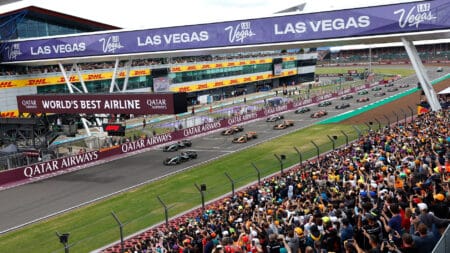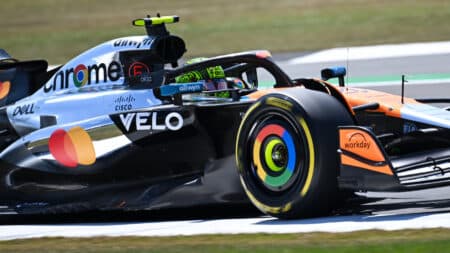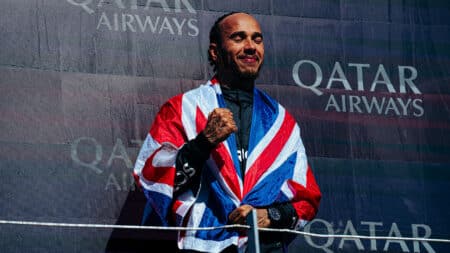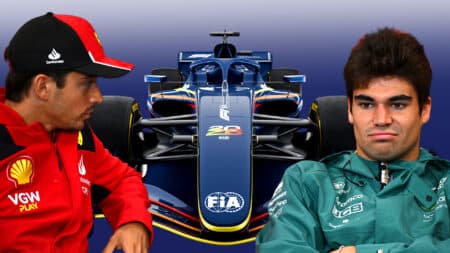
Tomorrow's F1 starting grid for the 2025 British Grand Prix
Max Verstappen will start on pole for the 2025 British Grand Prix after a brilliant last gasp qualifying lap. Here's how the starting grid looks for Sunday's race at Silverstone
A Hall of Fame special looking at four names from the shortlist: Rudolf Caracciola, Bernd Rosemeyer, Dan Gurney and Mika Häkkinen
Caracciola and Rosemeyer
Rudolf Caracciola was an old 34. Pain does that to you.
Twelve years of motor racing had exacted its toll. The (right) hip-and-thigh smashed at Monaco in 1933 was still giving Rudi gyp. Though he did all he could to conceal his limp from opposition and fans, it was becoming clear that the crucial final tenth – the last ounce of speed that had made him a match for Tazio Nuvolari in equal equipment – had been lost.

By way of compensation he was leaning on his experience, perfectionism and methodical approach, his firm grasp of strategy and strong bond with team boss Alfred Neubauer.
Caracciola was the human manifest of Mercedes-Benz: as conservative as it’s possible to be at 200mph on narrow and bumpy public roads; steadfast and loyal; and successful.
Bernd Rosemeyer was a young 25. Pain-free, carefree.
Inexperienced but brimming with cocksure confidence, he badgered his team boss into giving him his chance.
Rosemeyer would become the human manifest of nascent Auto Union: youthful, vigorous and daring to be different while still finding its feet; and successful.
The 1935 Eifelrennen, contested over 11 laps of the Nürburgring, was his second car race and first real test.
It’s unlikely that Caracciola paid the newcomer much attention – until he loomed in his mirrors. The acknowledged ‘King of the ’Ring’ had enough on his plate with hot-headed, lead-footed team-mates Manfred von Brauchitsch and Luigi Fagioli, plus mechanic-turned-driver newcomer Hermann Lang.

That changed conclusively at the start of lap nine when Rosemeyer passed him in front of a packed main grandstand to take the lead.
It was impressive and impertinent but hardly impetuous.
Though this ex-motorbike racer knew the circuit intimately, he had been circumspect throughout practice and continued that caution during the early wet stages of the race. Not until he was shown the Faster! signal at mid-distance – by which time he was Auto Union’s only hope – did Rosemeyer obediently and extravagantly increase his pace.
Once in the lead, and despite an aero-screen broken by a stone and a misfire, caused by changeable weather, that cost him two of his 16 cylinders, he fended off Caracciola for two laps.
The latter’s simmering mood can be imagined – and would be vented immediately after the race.
Caracciola won, in fact, having hung onto gears longer than he considered prudent as the pair accelerated onto the long and undulating final straight.
But Rosemeyer was undoubtedly the star of the show.
A scowling Caracciola forced through the mobbing crowd to administer an admonition: ‘Next time, use your head!’ He then handed the grinning runner-up a cocktail stick. Rosemeyer can be seen cheekily chewing it in photographs. Latterly he wore it as a buttonhole.
Caracciola ended 1935 with the first of his three AIACR European Championship titles, having won the French (not a counting round), Belgian, Swiss and Spanish GPs.
Rosemeyer’s would indeed be a mixed learning year that concluded, in the absence of Mercedes-Benz, with a prescient victory in Czechoslovakia.
The following season he taught the establishment such a harsh lesson that Mercedes-Benz shrunk early from the fray, injected new blood, rejected many long-held ideas and beliefs and built GP racing’s most magnificent machine: W125.
Only an Auto Union driven by Rosemeyer could hold a candle to it – and with it, Caracciola secured his second European title.
Rosemeyer was dead by the time of his third in 1938.
Caracciola was not enamoured with the regular record-breaking runs undertaken on Nazi Germany’s autobahns, but the prestige they gained him undoubtedly bolstered his position within the team.

Rosemeyer was under no such internecine pressure. Yet Auto Union’s number one felt the need to good-naturedly wave away his friend and rival’s urging for a postponement as a chill breeze gathered on 28 January.
Caracciola had clocked 268.6mph over the flying mile in the still air of the early morning; Rosemeyer was travelling even faster when a gust spirited him away.
Having, in the final reckoning, been impetuous, he would never get old.
Caracciola, in turn, died a very old 58 in 1959, heavy tolls exacted by two post-war crashes having further lowered his body’s defences. Eventually he had leaned too much on experience when perhaps he should have used his head.
From the archive: Bernd Rosemeyer, the Villeneuve of the ’30s (2013)
Gurney and Häkkinen
Operating in someone else’s era – Dan Gurney in Clark’s and Mika Häkkinen in Schumacher’s – has benefits within its ultimate frustration. The pressure of expectation is on the other guy while your successes assume greater meaning.
The garrulous American and the Finn for whom public speaking was no picnic – Häkkinen for President! hardly – were selected by their peer as the best of the rest.
Poignantly Gurney only discovered this when James Clark Sr confided in him at the funeral: Dan was the man whom Jim Jr had feared most.
Schumacher spoke openly about the threat Häkkinen (in Newey-designed McLarens) posed him. To be fair, it was more obvious: Michael and Mika were head and shoulders better than the others, whereas Gurney, though tall for a racing driver, was butting heads with the likes of Jack Brabham, Graham Hill, Jackie Stewart and John Surtees, as well as Clark.
The fighter pilot camaraderie of the 1960s had long since evaporated by the time Schumacher edged Häkkinen towards the grass at 200mph at Spa. Air had become dirty.
Mika’s revenge pass is rightly remembered as one of F1’s greatest, for not only was it brave and brilliant but also it was rare. As was Schumacher’s post-race response to Mika’s – and this is relative – letting rip about dangerous tactics: Michael listened for once, gave him the time of day.

A fortnight later Häkkinen wrapped a consoling arm around Schumacher when he burst into tears during the TV press conference at Monza. That their relationship appeared gawky was symptomatic of an increasingly clinical sport. That it existed at all bucked it.
It was at Spa in 1964 that Gurney in a Brabham laid waste to the superiority of Clark and the Lotus 25 – only to run out of fuel within sight of victory.
Clark ran dry, too, and joined his friend by the side of the road at Stavelot. There they chatted about their fates – no doubt both relieved to have survived the old Spa for another year – both men oblivious to the fact that Clark had won.
They became more animated when the result was announced over the Tannoy, their body language and facial expressions warm and entirely natural despite the unnatural circumstances.
Emotion is never far from the surface – for the listener, too – when Gurney speaks of Clark today.
From the archive: Lunch with Dan Gurney (2009)
Häkkinen knows death also, from the time when he operated in Senna’s era: he weaved his McLaren through the settling debris field at Tamburello.
And at Adelaide in 1995, he himself was saved only by the swift and expert responses of the rescue crews.

These ‘brushes’ made him a more thoughtful competitor. Racing for him wasn’t the cutthroat business it was for Schumacher.
Though he did all that he could to conceal the toll that the sport was exacting – crouching beneath Monza’s trees to cry away disappointment – it was clear by 2001 that this two-time world champion had reached the end of his F1 tether.
It was supposed to be a sabbatical but soon became a retirement.
He was 33 but looked older.
From the archive: Lunch with Mika Häkkinen (2010)
Gurney was 39 but looked younger when he finished his F1 career as a three-race replacement for the late Bruce McLaren in mid-1970.
Always a thinking competitor, he stopped driving because the logistics of his expanding All American Racers was demanding more of his time.
Gurney and Häkkinen: the absolute very best of the best of the rest.

Max Verstappen will start on pole for the 2025 British Grand Prix after a brilliant last gasp qualifying lap. Here's how the starting grid looks for Sunday's race at Silverstone

Austrian GP winner Norris went quickest at Silverstone during the Friday F1 practice sessions ahead of the 2025 British Grand Prix

Lewis Hamilton hadn't won in almost three years – and then produced a sensational victory at Silverstone 2024. James Elson explains why it was his best ever

As more drivers get a feel for the 2026 Formula 1 cars in simulators, concern is growing that the new regulations may sacrifice driving enjoyment in pursuit of technical ambition, as Mark Hughes reports